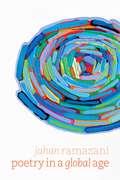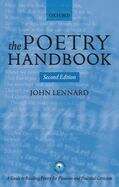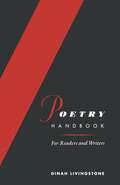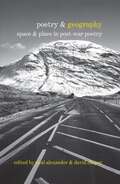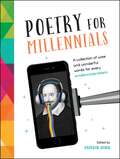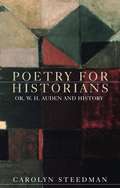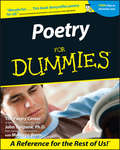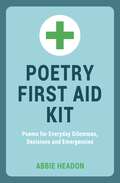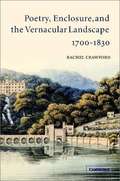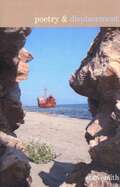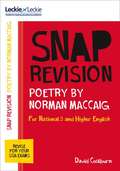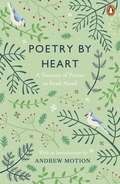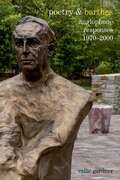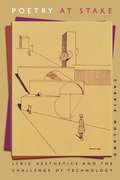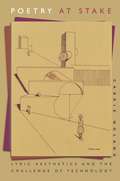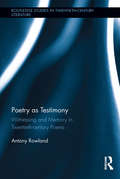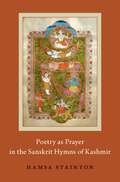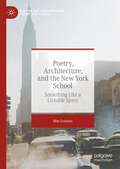- Table View
- List View
Poetry in a Global Age
by Jahan RamazaniIdeas, culture, and capital flow across national borders with unprecedented speed, but we tend not to think of poems as taking part in globalization. Jahan Ramazani shows that poetry has much to contribute to understanding literature in an extra-national frame. Indeed, the globality of poetry, he argues, stands to energize the transnational turn in the humanities. Poetry in a Global Age builds on Ramazani’s award-winning A Transnational Poetics, a book that had a catalytic effect on literary studies. Ramazani broadens his lens to discuss modern and contemporary poems not only in relation to world literature, war, and questions of orientalism but also in light of current debates over ecocriticism, translation studies, tourism, and cultural geography. He offers brilliant readings of postcolonial poets like Agha Shahid Ali, Lorna Goodison, and Daljit Nagra, as well as canonical modernists such as W. B. Yeats, Wallace Stevens, T. S. Eliot, and Marianne Moore. Ramazani shows that even when poetry seems locally rooted, its long memory of forms and words, its connections across centuries, continents, and languages, make it a powerful imaginative resource for a global age. This book makes a strong case for poetry in the future development of world literature and global studies.
Poetry in a Global Age
by Jahan RamazaniIdeas, culture, and capital flow across national borders with unprecedented speed, but we tend not to think of poems as taking part in globalization. Jahan Ramazani shows that poetry has much to contribute to understanding literature in an extra-national frame. Indeed, the globality of poetry, he argues, stands to energize the transnational turn in the humanities. Poetry in a Global Age builds on Ramazani’s award-winning A Transnational Poetics, a book that had a catalytic effect on literary studies. Ramazani broadens his lens to discuss modern and contemporary poems not only in relation to world literature, war, and questions of orientalism but also in light of current debates over ecocriticism, translation studies, tourism, and cultural geography. He offers brilliant readings of postcolonial poets like Agha Shahid Ali, Lorna Goodison, and Daljit Nagra, as well as canonical modernists such as W. B. Yeats, Wallace Stevens, T. S. Eliot, and Marianne Moore. Ramazani shows that even when poetry seems locally rooted, its long memory of forms and words, its connections across centuries, continents, and languages, make it a powerful imaginative resource for a global age. This book makes a strong case for poetry in the future development of world literature and global studies.
Poetry in a Global Age
by Jahan RamazaniIdeas, culture, and capital flow across national borders with unprecedented speed, but we tend not to think of poems as taking part in globalization. Jahan Ramazani shows that poetry has much to contribute to understanding literature in an extra-national frame. Indeed, the globality of poetry, he argues, stands to energize the transnational turn in the humanities. Poetry in a Global Age builds on Ramazani’s award-winning A Transnational Poetics, a book that had a catalytic effect on literary studies. Ramazani broadens his lens to discuss modern and contemporary poems not only in relation to world literature, war, and questions of orientalism but also in light of current debates over ecocriticism, translation studies, tourism, and cultural geography. He offers brilliant readings of postcolonial poets like Agha Shahid Ali, Lorna Goodison, and Daljit Nagra, as well as canonical modernists such as W. B. Yeats, Wallace Stevens, T. S. Eliot, and Marianne Moore. Ramazani shows that even when poetry seems locally rooted, its long memory of forms and words, its connections across centuries, continents, and languages, make it a powerful imaginative resource for a global age. This book makes a strong case for poetry in the future development of world literature and global studies.
The Poetry Handbook (PDF)
by John LennardThe Poetry Handbook is a lucid and entertaining guide to the poet's craft, and an invaluable introduction to practical criticism for students. Chapters on each element of poetry, from metre to gender, offer a wide-ranging general account, and end by looking at two or three poems from a small group (including works by Donne, Elizabeth Bishop, Geoffrey Hill, and Nobel Laureate Derek Walcott), to build up sustained analytical readings. Thorough and compact, with notes and quotations supplemented by detailed reference to the Norton Anthology of Poetry and a companion website with texts, links, and further discussion, The Poetry Handbook is indispensable for all school and undergraduate students of English. A final chapter addresses examinations of all kinds, and sample essays by undergraduates are posted on the website. Critical and scholarly terms are italicised and clearly explained, both in the text and in a complete glossary; the volume also includes suggestions for further reading. The first edition, widely praised by teachers and students, showed how the pleasures of poetry are heightened by rigorous understanding and made that understanding readily available. This second edition - revised, expanded, updated, and supported by a new companion website - confirm The Poetry Handbook as the best guide to poetry available in English.
Poetry Handbook: For Readers and Writers
by Dinah LivingstoneThis poetry handbook is for anyone interested in poetry today - members of poetry workshops, students, or individuals at home. It covers traditional metres, sound patterns and forms but its emphasis is strongly on the more difficult questions of the rhythm, sound and shape of contemporary poetry. It discusses poetry's content and scope, poetry in society: both in Britain and by way of contrast, revolutionary Nicaragua. This is followed by a chapter on translating poetry. The conclusion makes some suggestions about where to look or go for poetry in Britain today.
Poetry & Geography: Space & Place in Post-war Poetry (Poetry &... #5)
by Neal Alexander David CooperPoetry & Geography examines the rich diversity of geographical imaginations informing post-war and contemporary poetry in Britain and Ireland. Drawing impetus from the spatial turn in the humanities and social sciences, the fourteen essays collected here appraise the significance of ideas of space, place, and landscape for ‘mainstream’ and ‘experimental’ poets, post-romantics and neo-modernists alike. Cumulatively, the book’s varied articulations of poetry and geography sketch out a series of intersections between language and location, form and environment, sound and space. Poetry’s unique capacity to invigorate and expand our vocabularies of site and situation, of our manifold relations with the world outside us, is described and explored. Bringing together fresh, interdisciplinary readings of poets as diverse as Roy Fisher and R.S. Thomas, John Burnside and Thomas Kinsella, Jo Shapcott and Peter Riley, Alice Oswald and Ciaran Carson, Poetry & Geography sketches a topographical map of shared poetic terrains. It contributes to a fertile set of dialogues between literary studies and cultural geography in which the valences of space and place are open to processes of contestation and reimagining. This new collection of critical essays provides readers with a vital set of coordinates in a complex and evolving field. Key themes include: place and identity; literary cartographies; walking as trope and spatial practice; the poetics of edges, margins, and peripheries; landscape, language, and form.
Poetry for Millennials: A Collection of Wise and Wonderful Words for Every #MillennialProblem
by Tamsin KingWhen your partner spends too much time on their Xbox:Why so pale and wan, fond lover? Prithee, why so pale? from ‘Why So Pale and Wan?’, John Suckling From dating and house-shares to digital detoxing and growing up, Poetry for Millennials is the answer to all your hardships and woes. It offers relatable verse from some of our greatest literary figures to help you laugh away the most common millennial problems *after wiping away your tears*.
Poetry for historians: Or, W. H. Auden and history
by Carolyn SteedmanWhat is the point of poetry for historians? The answer lies in this new 'history of history', which looks at the question through the prism of W. H. Auden’s Cold War history poems and of poetry and history education from the eighteenth century to the present day.
Poetry for historians: Or, W. H. Auden and history
by Carolyn SteedmanWhat is the point of poetry for historians? The answer lies in this new 'history of history', which looks at the question through the prism of W. H. Auden’s Cold War history poems and of poetry and history education from the eighteenth century to the present day.
Poetry For Dummies (For Dummies Ser.)
by The Poetry Center John TimpaneSometimes it seems like there are as many definitions of poetry asthere are poems. Coleridge defined poetry as "the best wordsin the best order." St. Augustine called it "theDevil's wine." For Shelley, poetry was "therecord of the best and happiest moments of the happiest and bestminds." But no matter how you define it, poetry has exerciseda hold upon the hearts and minds of people for more than fivemillennia. That's because for the attentive reader, poetryhas the power to send chills shooting down the spine and lightningbolts flashing in the brain - to throw open thedoors of perception and hone our sensibilities to a scalpel'sedge. Poetry For Dummies is a great guide to reading andwriting poems, not only for beginners, but for anyone interested inverse. From Homer to Basho, Chaucer to Rumi, Shelley toGinsberg, it introduces you to poetry's greatestpractitioners. It arms you with the tools you need to understandand appreciate poetry in all its forms, and to explore your owntalent as a poet. Discover how to: Understand poetic language and forms Interpret poems Get a handle on poetry through the ages Find poetry readings near you Write your own poems Shop your work around to publishers Don't know the difference between an iamb and a trochee?Worry not, this friendly guide demystifies the jargon, and itcovers a lot more ground besides, including: Understanding subject, tone, narrative; and poeticlanguage Mastering the three steps to interpretation Facing the challenges of older poetry Exploring 5,000 years of verse, from Mesopotamia to the globalvillage Writing open-form poetry Working with traditional forms of verse Writing exercises for aspiring poets Getting published From Sappho to Clark Coolidge, and just about everyone inbetween, Poetry For Dummies puts you in touch with thegreats of modern and ancient poetry. Need guidance on composing aghazal, a tanka, a sestina, or a psalm? This is the book foryou.
Poetry First Aid Kit: Poems For Everyday Dilemmas, Decisions and Emergencies
by Abbie HeadonWhether your dilemma is something as simple as a what to have for dinner or you are trying to make a life-changing decision, the Poetry First Aid Kit has the answer. Seek a solution within these stanzas and let the enlightening limericks and illuminating iambic pentameter help you resolve the dilemmas in your life.
Poetry, Enclosure, And The Vernacular Landscape, 1700-1830 (PDF)
by Rachel CrawfordRachel Crawford examines the intriguing, often problematic, relationship between poetry and landscape in eighteenth- and early nineteenth-century Britain. Crawford focuses on the gradual change during this period when the British taste for open space gradually gave way to a preference for confined space, so that by the beginning of the Regency period contained sites, both topographical and poetic, were perceived to express authentic English qualities. In this context, Crawford discusses the highly fraught parliamentary enclosure movement, which closed off the last of England's open fields between 1760 and 1815. Crawford takes enclosure as a prevailing metaphor for a reconceptualisation of the aesthetics of space in which enclosed and confined sites became associated with productivity, and sets explicit images, such as the apple, the iron industry, and the kitchen garden within the context of georgic and minor lyric poetry.
Poetry & Displacement (Poetry &... #1)
by Stan SmithThe paradigmatic figure of twentieth-century history is the ‘displaced person’, a concept which emerged from the demographic migrations, deportations and genocidal purges that accompanied two world wars, the destruction and construction of nation states and the restructuring of the global order which they occasioned. These processes almost inevitably fostered a poetry of exile and expatriation intimately bound up with the experience of modernity and the culture of modernism, culminating, in the postcolonial era, with the globalisation of displacement as the determining condition of postmodernity. In this timely new volume renowned poetry critic Stan Smith examines a number of poets – Plath, Larkin, Heaney, Walcott, Middleton, Fisher, Duffy – through the lens of displacement.
Poetry & Commons: Postwar and Romantic Lyric in Times of Enclosure (Poetry &... #13)
by Daniel EltringhamWinner of the ASLE-UKI Book Prize 2023. The commons and enclosure are among the most vital ways of thinking about poetry today, posing urgent ecological and political questions about land and resource ownership and use. Poetry & Commons is the first study to read postwar and contemporary poetry through this lens, by putting it in dialogue with the Romantic experience of agrarian dispossession. Employing an innovative transhistorical structure, the book demonstrates how radical Anglophone poetries since 1960 have returned to the 'enclosure of the commons' in response to political and ecological crises. It identifies a 'commons turn' in contemporary lyric that contests the new enclosures of globalized capital and resource extraction. In lucid close readings of a rich field of experimental poetries associated with the 'British Poetry Revival', as well as from Canada and the United States, it analyses a landscape poetics of enclosure in relationship with Romantic verse. Canonical Romantic poetry by Wordsworth and Clare is understood through the fine-grain textures of the period’s vernacular and radical verse and discourse around enclosure, which the book demonstrates contain the seeds of neoliberal political economy. Engaging with the work of Anne-Lise François and Anna Tsing, Poetry & Commons theorizes commoning as marking out subsistence 'rhythms of resource', which articulate plural, irregular, and tentative relations between human and nonhuman lifeworlds.
Poetry By Norman Maccaig (Leckie And Leckie Snap Revision Ser. (PDF))
by David CockburnExam Board: SQA Level: N5/Higher Subject: English First teaching: September 2018; First exams: May 2019 Revise N5/Higher English in a snap. Need extra help with 'Poetry by Norman MacCaig', ahead of the exam? Revise and review your understanding of themes, structure and poetic techniques with this handy A5, exam-focused guide. With lots of practice and tips for your SQA exam, this 'Poetry by Norman MacCaig Snap Revision Text Guide' contains all the key information you need to get a top mark.
Poetry by Heart: Poems for Learning and Reciting
by Julie Blake Jean Sprackland Mike Dixon Andrew Motion Motion AndrewPoetry by Heart - based on the hugely successful nationwide schools competition, 200 magical poems to learn by heart'The poems we learn stay with us for the rest of our lives. They become personal and invaluable, and what's more they are free gifts - there for the taking' Simon ArmitageTwo years ago former Poet Laureate Andrew Motion had the idea of setting up Poetry by Heart - a nationwide annual competition for secondary schools which asked contestants to learn two or three poems and be judged on their recitations, first at school level, then regional, then in a national final held at London's National Portrait Gallery. It's proved a huge success, with hundreds of schools participating in the first year, and numbers up by 20% in the second. Coinciding with the start of the third year of competition, and published on National Poetry Day whose theme coincidentally in 2014 is Recitation, this Poetry by Heart anthology brings together the pool of poems - 200 altogether - from which contestants make their choices. Specially picked by Motion and his three co-editors, these poems make up a treasure house - of almost-unknown poems and familiar poems from the mainstream; love poems and war poems; funny poems and heartbroken poems; poems that recreate the world we know and poems written on the dark side of the moon. And all chosen with a view to their being recited out loud.From William Wordsworth to Wilfred Owen, Emily Brontë to Elizabeth Bishop this wonderfully enjoyable anthology will be enjoyed by all ages and includes the best poets from the past to the present day. In a groundbreaking feature, the book includes QR codes which allow readers to use their mobile phones to listen to recordings of the poems - many of them specially recorded by the poets themselves. Sir Andrew Motion was Poet Laureate from 1999 till 2009, and is Professor of Creative Writing at Royal Holloway College, London. Jean Sprackland'sTilt won the Costa Poetry award in 2008. She is a Reader in Poetry at Manchester Metropolitan University. Julie Blake is co-Founder and Director of The Full English, an organization based in Bristol which provides support to teachers of English Literature. Mike Dixon is an educational consultant specializing in English in the classroom.
Poetry & Barthes: Anglophone Responses 1970–2000 (Poetry &... #7)
by Callie GardnerWhat kinds of pleasure do we take from writing and reading? What authority has the writer over a text? What are the limits of language’s ability to communicate ideas and emotions? Moreover, what are the political limitations of these questions? The work of the French cultural critic and theorist Roland Barthes (1915–80) poses these questions, and has become influential in doing so, but the precise nature of that influence is often taken for granted. This is nowhere more true than in poetry, where Barthes’ concerns about pleasure and origin are assumed to be relevant, but this has seldom been closely examined. This innovative study traces the engagement with Barthes by poets writing in English, beginning in the early 1970s with one of Barthes’ earliest Anglophone poet readers, Scottish poet-theorist Veronica Forrest-Thomson (1947–75). It goes on to examine the American poets who published in L=A=N=G=U=A=G=E and other small but influential journals of the period, and other writers who engaged with Barthes later, considering his writings’ relevance to love and grief and their treatment in poetry. Finally, it surveys those writers who rejected Barthes’ theory, and explores why this was. The first study to bring Barthes and poetry into such close contact, this important book illuminates both subjects with a deep contemplation of Barthes’ work and a range of experimental poetries.
Poetry at Stake: Lyric Aesthetics and the Challenge of Technology
by Carrie NolandTaking seriously Guillaume Apollinaire's wager that twentieth-century poets would one day "mechanize" poetry as modern industry has mechanized the world, Carrie Noland explores poetic attempts to redefine the relationship between subjective expression and mechanical reproduction, high art and the world of things. Noland builds upon close readings to construct a tradition of diverse lyricists--from Arthur Rimbaud, Blaise Cendrars, and René Char to contemporary performance artists Laurie Anderson and Patti Smith--allied in their concern with the nature of subjectivity in an age of mechanical reproduction.
Poetry at Stake: Lyric Aesthetics and the Challenge of Technology
by Carrie NolandTaking seriously Guillaume Apollinaire's wager that twentieth-century poets would one day "mechanize" poetry as modern industry has mechanized the world, Carrie Noland explores poetic attempts to redefine the relationship between subjective expression and mechanical reproduction, high art and the world of things. Noland builds upon close readings to construct a tradition of diverse lyricists--from Arthur Rimbaud, Blaise Cendrars, and René Char to contemporary performance artists Laurie Anderson and Patti Smith--allied in their concern with the nature of subjectivity in an age of mechanical reproduction.
Poetry at Stake: Lyric Aesthetics and the Challenge of Technology
by Carrie NolandTaking seriously Guillaume Apollinaire's wager that twentieth-century poets would one day "mechanize" poetry as modern industry has mechanized the world, Carrie Noland explores poetic attempts to redefine the relationship between subjective expression and mechanical reproduction, high art and the world of things. Noland builds upon close readings to construct a tradition of diverse lyricists--from Arthur Rimbaud, Blaise Cendrars, and René Char to contemporary performance artists Laurie Anderson and Patti Smith--allied in their concern with the nature of subjectivity in an age of mechanical reproduction.
Poetry as Testimony: Witnessing and Memory in Twentieth-century Poems (Routledge Studies in Twentieth-Century Literature)
by Antony RowlandThis book analyzes Holocaust poetry, war poetry, working-class poetry, and 9/11 poetry as forms of testimony. Rowland argues that testamentary poetry requires a different approach to traditional ways of dealing with poems due to the pressure of the metatext (the original, traumatic events), the poems’ demands for the hyper-attentiveness of the reader, and a paradox of identification that often draws the reader towards identifying with the poet’s experience, but then reminds them of its sublimity. He engages with the work of a diverse range of twentieth-century authors and across the literature of several countries, even uncovering new archival material. The study ends with an analysis of the poetry of 9/11, engaging with the idea that it typifies a new era of testimony where global, secondary witnesses react to a proliferation of media images. This book ranges across the literature of several countries, cultures, and historical events in order to stress the large variety of contexts in which poetry has functioned productively as a form of testimony, and to note the importance of the availability of translations to the formation of literary canons.
Poetry as Testimony: Witnessing and Memory in Twentieth-century Poems (Routledge Studies in Twentieth-Century Literature)
by Antony RowlandThis book analyzes Holocaust poetry, war poetry, working-class poetry, and 9/11 poetry as forms of testimony. Rowland argues that testamentary poetry requires a different approach to traditional ways of dealing with poems due to the pressure of the metatext (the original, traumatic events), the poems’ demands for the hyper-attentiveness of the reader, and a paradox of identification that often draws the reader towards identifying with the poet’s experience, but then reminds them of its sublimity. He engages with the work of a diverse range of twentieth-century authors and across the literature of several countries, even uncovering new archival material. The study ends with an analysis of the poetry of 9/11, engaging with the idea that it typifies a new era of testimony where global, secondary witnesses react to a proliferation of media images. This book ranges across the literature of several countries, cultures, and historical events in order to stress the large variety of contexts in which poetry has functioned productively as a form of testimony, and to note the importance of the availability of translations to the formation of literary canons.
Poetry as Prayer in the Sanskrit Hymns of Kashmir (AAR Religion in Translation)
by Hamsa StaintonHistorically, Kashmir was one of the most dynamic and influential centers of Sanskrit learning and literary production in South Asia. In Poetry as Prayer in the Sanskrit Hymns of Kashmir, Hamsa Stainton investigates the close connection between poetry and prayer in South Asia by studying the history of Sanskrit hymns of praise (stotras) in Kashmir. The book provides a broad introduction to the history and general features of the stotra genre, and it charts the course of these literary hymns in Kashmir from the eighth century to the present. In particular, it offers the first major study in any European language of the Stutikusum=añjali, an important work of religious literature dedicated to the god 'Siva and one of the only extant witnesses to the trajectory of Sanskrit literary culture in fourteenth-century Kashmir. The book also contributes to the study of 'Saivism by examining the ways in which 'Saiva poets have integrated the traditions of Sanskrit literature and poetics, theology (especially non-dualism), and 'Saiva worship and devotion. It substantiates the diverse configurations of 'Saiva bhakti expressed and explored in these literary hymns and the challenges they present for standard interpretations of Hindu bhakti. More broadly, this study of stotras from Kashmir offers new perspectives on the history and vitality of prayer in South Asia and its complex relationships to poetry and poetics.
Poetry as Prayer in the Sanskrit Hymns of Kashmir (AAR Religion in Translation)
by Hamsa StaintonHistorically, Kashmir was one of the most dynamic and influential centers of Sanskrit learning and literary production in South Asia. In Poetry as Prayer in the Sanskrit Hymns of Kashmir, Hamsa Stainton investigates the close connection between poetry and prayer in South Asia by studying the history of Sanskrit hymns of praise (stotras) in Kashmir. The book provides a broad introduction to the history and general features of the stotra genre, and it charts the course of these literary hymns in Kashmir from the eighth century to the present. In particular, it offers the first major study in any European language of the Stutikusum=añjali, an important work of religious literature dedicated to the god 'Siva and one of the only extant witnesses to the trajectory of Sanskrit literary culture in fourteenth-century Kashmir. The book also contributes to the study of 'Saivism by examining the ways in which 'Saiva poets have integrated the traditions of Sanskrit literature and poetics, theology (especially non-dualism), and 'Saiva worship and devotion. It substantiates the diverse configurations of 'Saiva bhakti expressed and explored in these literary hymns and the challenges they present for standard interpretations of Hindu bhakti. More broadly, this study of stotras from Kashmir offers new perspectives on the history and vitality of prayer in South Asia and its complex relationships to poetry and poetics.
Poetry, Architecture, and the New York School: Something Like a Liveable Space (Modern and Contemporary Poetry and Poetics)
by Mae LosassoPoetry, Architecture, and the New York School: Something Like a Liveable Space examines the relationship between poetics and architecture in the work of the first generation New York School poets, Frank O’Hara, John Ashbery, Barbara Guest, and James Schuyler. Reappraising the much-debated New York School label, Mae Losasso shows how these writers constructed poetic spaces, structures, surfaces, and apertures, and sought to figure themselves and their readers in relation to these architextual sites. In doing so, Losasso reveals how the built environment shapes the poetic imagination and how, in turn, poetry alters the way we read and inhabit architectural space. Animated by archival research and architectural photographs, Poetry, Architecture, and the New York School marks a decisive interdisciplinary turn in New York School studies, and offers new frameworks for thinking about postmodern American poetry in the twenty-first century.
